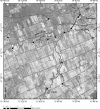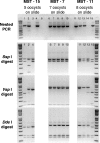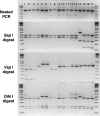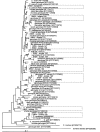Tracking host sources of Cryptosporidium spp. in raw water for improved health risk assessment
- PMID: 17483276
- PMCID: PMC1932708
- DOI: 10.1128/AEM.02788-06
Tracking host sources of Cryptosporidium spp. in raw water for improved health risk assessment
Abstract
Recent molecular evidence suggests that different species and/or genotypes of Cryptosporidium display strong host specificity, altering our perceptions regarding the zoonotic potential of this parasite. Molecular forensic profiling of the small-subunit rRNA gene from oocysts enumerated on microscope slides by U.S. Environmental Protection Agency method 1623 was used to identify the range and prevalence of Cryptosporidium species and genotypes in the South Nation watershed in Ontario, Canada. Fourteen sites within the watershed were monitored weekly for 10 weeks to assess the occurrence, molecular composition, and host sources of Cryptosporidium parasites impacting water within the region. Cryptosporidium andersoni, Cryptosporidium muskrat genotype II, Cryptosporidium cervine genotype, C. baileyi, C. parvum, Cryptosporidium muskrat genotype I, the Cryptosporidium fox genotype, genotype W1, and genotype W12 were detected in the watershed. The molecular composition of the Cryptosporidium parasites, supported by general land use analysis, indicated that mature cattle were likely the main source of contamination of the watershed. Deer, muskrats, voles, birds, and other wildlife species, in addition to sewage (human or agricultural) may also potentially impact water quality within the study area. Source water protection studies that use land use analysis with molecular genotyping of Cryptosporidium parasites may provide a more robust source-tracking tool to characterize fecal impacts in a watershed. Moreover, the information is vital for assessing environmental and human health risks posed by water contaminated with zoonotic and/or anthroponotic forms of Cryptosporidium.
Figures





References
-
- Boutros, S. N. 1989. Sampling and analysis for Cryptosporidium in PA public surface water supply sources. Pennsylvania Division of Water Supply, Harrisburg, PA.
-
- Brookes, J. D., M. R. Hipsey, M. D. Burch, R. H. Regel, L. G. Linden, C. M. Ferguson, and J. P. Antenucci. 2005. Relative value of surrogate indicators for detecting pathogens in lakes and reservoirs. Environ. Sci. Technol. 39:8614-8621. - PubMed
-
- Drinking Water Inspectorate. 2000. The water supply (water quality) regulations 2000. http://www.dwi.gov.uk/regs/si3184/3184.htm#273184. [Online.]
-
- Enemark, H. L., P. Ahrens, C. J. Lowery, S. M. Thamsborg, J. M. Enemark, V. Bille-Hansen, and P. Lind. 2002. Cryptosporidium andersoni from a Danish cattle herd: identification and preliminary characterisation. Vet. Parasitol. 107:37-49. - PubMed
Publication types
MeSH terms
Substances
Associated data
- Actions
- Actions
- Actions
- Actions
- Actions
- Actions
LinkOut - more resources
Full Text Sources
Molecular Biology Databases
Miscellaneous

